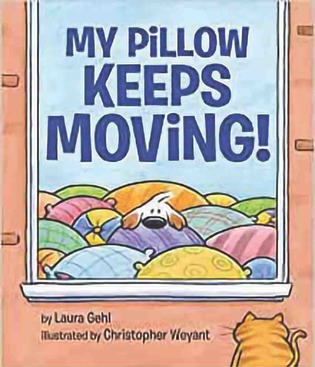
Recent picture books by alumni
My Pillow Keeps Moving (Viking, $17.99) — Laura Gehl ’99; illustrated by Christopher Weyant
We open on a chilly street corner. A shivering dog and cat are looking wistfully through the gleaming window of Pillow Palace, its marketing display piled high with enticing soft and fluffy pillows. In a moment of bravery, or desperation, the spotted dog slips through the door and settles herself atop the cozy pillow mountain. Moments later—mistaken for a pillow—she finds herself in a shopping bag, being taken home by a customer who’s about to get more than he bargained for. And thus begins Gehl’s thoroughly charming comedy of errors, a humorous tale of mistaken identity, consumer warranties, and the value of being yourself. With a style reminiscent of Curious George, Weyant brings the zaniness to life through vivid facial expressions, as well as corporate swag that pokes fun at the dark realities of late-stage capitalism. A real treat with a heartwarming message.
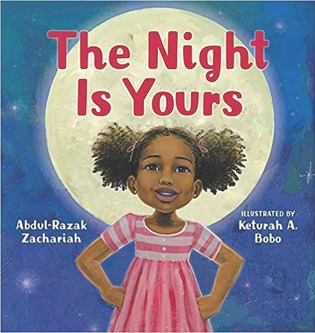
The Night Is Yours (Dial Books for Young Readers, $17.99) — Abdul-Razak Zachariah ’17; illustrated by Keturah A. Bobo
With lush, saturated illustrations, The Night Is Yours celebrates the sweetness of summer in the city. The narrator, a father, watches his daughter Amani as she plays with her friends in the courtyard of their apartment complex: double-dutching, dancing to the hip-hop music floating from a neighboring apartment, and searching out the last person in a game of hide-and-seek. Inspired by Zachariah’s own experience of growing up in West Haven, Connecticut, the story is brimming with love for black communities and shot through with a nostalgia for the simple yet extraordinary pleasure of a summer’s night under the moon. Bobo’s illustrations beautifully render the night, the children’s textured hair—curls, afros, puffs—and the spectrum of skin colors, from tans to deep browns. A wonderful bedtime book, The Night is Yours affirms the treasure of close communities and that night is sweet, safe, and belongs to children.
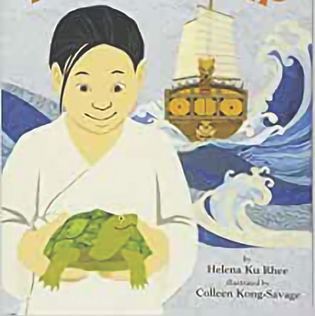
The Turtle Ship (Shen’s Books, $17.95) — Helena Ku Rhee ’96; illustrated by Colleen Kong-Savage
In a small village in long-ago Korea, the young Sun-sin spends his days at the seashore with his pet turtle, Gobugi. The two swim and watch the ships in the harbor, and Sun-sin dreams of travel to distant lands. The budding explorer gets his chance when the king announces a contest: whoever designs the best battleship will sail the world with the royal navy. Despite his youth, and his family’s limited resources, Sun-sin begins to plan, ultimately drawing inspiration from his friend Gobugi, the turtle. The Turtle Ship is based loosely on the real-life figure of Admiral Yi Sun-sin, who designed the Gobukson, the renowned Korean battleship, in the 1500s. The book is a heartwarming tale of friendship, bravery, and engineering, brought to life by Kong-Savage’s stunning, collage-like illustrations that are rich with texture, artistry, and emotion.
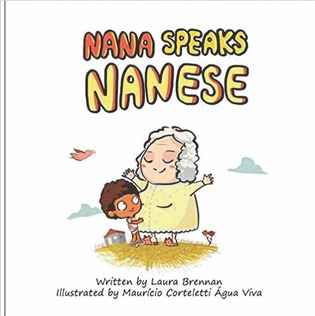
Nana Speaks Nanese (self-published, $12.99)— Laura Brennan ’88; illustrated by Maurício Corteletti Água Viva
When Nana moves in, she feeds the birds, listens patiently as the young narrator reads from his favorite book, Papillon, and delights in her favorite dessert: ice cream. But life with Nana isn’t always easy. Sometimes Nana struggles to recognize where she is and wanders away from home, at other times she calls the narrator the wrong name or wrong gender, and occasionally she speaks using words that aren’t actually words, a language entirely her own that the family dubs Nanese. Through a series of sweet and inventive analogies, Nana Speaks Nanese tackles the challenges of memory disorders with grace. The young narrator’s parents honor his feelings of frustration while helping him to understand Nana’s illness and how the family can best support her. “She may forget your name,” the narrator’s father explains, “but Nana will always remember how much she loves you.”
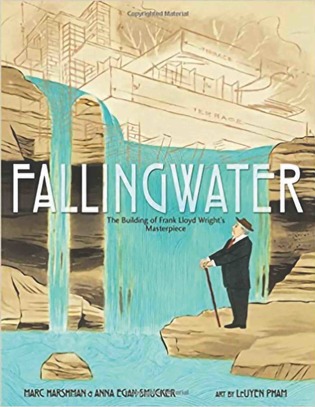
Fallingwater (Roaring Book Press, $18.99) — Marc Harshman ’75MDiv and Anna Egan Smucker; illustrated by LeUyen Pham
Perhaps best suited for the cerebral young reader, Fallingwater chronicles the building of Frank Lloyd Wright’s most celebrated construction. Harshman, who is the poet laureate of West Virginia, weaves a lyric tale of Wright’s journey, bringing him from a moment when his career seemed in decline and through his time at Bear Run—a long period of observation and meditation (but very few plans) that panicked his assistants. The bulk of the narrative takes readers through the building of the home and Wright’s rationale behind its famous features. The illustrations, though beautiful and evocative, are no substitute for the visceral experience of place, and some readers might benefit from photos or video to more fully understand the magnitude of the undertaking. Ultimately, the book is a kind of love letter to Wright’s genius, each page shot through with admiration for his vision, and championing the transformative power of patience, imagination,
and possibility.
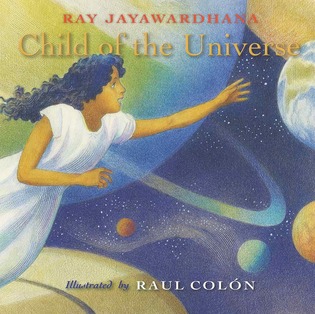
Child of the Universe (Make Me a World, $17.99) — Ray Jayawardhana ’94; illustrated by Raul Colón
“The iron in your blood, the calcium in your bones, are made up of stars that lived long ago,” a father explains to his daughter. Told in rhyming couplets, Child of the Universe is a poetic meditation on the mysterious powers of love and the universe. In his text, Jayawardhana—an astrophysicist—articulates a profound awe for a precious child and the forces that made her, and all life, possible. In complement, Colón’s illustrations of swirling color depict the girl moving serenely through galaxies and planetary landscapes. A soothing bedtime read, Child of the Universe speaks to the interconnectedness of all life, the strength of a father’s love, and our human place in the wider cosmos.
 loading
loading




